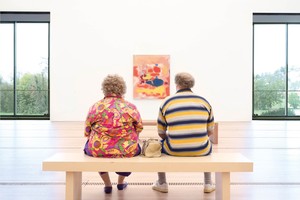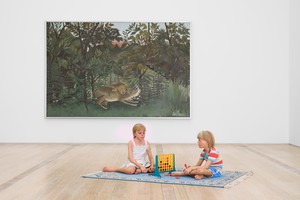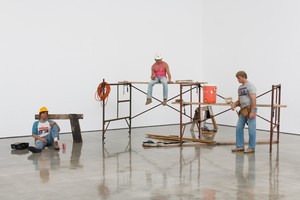
Duane Hanson: To Shock Ourselves
On the occasion of an exhibition at Fondation Beyeler, novelist Rachel Cusk considers the ethical and aesthetic arrangements that Duane Hanson’s sculpture initiates within the viewer.
My art is not about fooling people. It’s the human attitudes I’m after—fatigue, a bit of frustration, rejection. To me, there is a kind of beauty in all this.
—Duane Hanson
With a sculptural practice centered on hyperrealistic depictions of ordinary working-class subjects, Duane Hanson (1925–1996) created a distinctive body of work that tests the boundaries between reality and its representation. Eschewing the abstract art of the 1950s and ’60s, Hanson pursued a figurative approach in line with Pop art’s return to representation. His directness and unflinching eye for contemporary American life resulted in socially conscious sculptures that are at once familiar and poignant.
Born in 1925 in Alexandria, Minnesota, Hanson received a BA from Macalester College in Saint Paul, Minnesota. He later completed an MFA in sculpture at Cranbrook Academy of Art in Bloomfield Hills, Michigan, where he studied with Swedish sculptor Carl Milles. After finishing graduate school, Hanson took a position teaching art in Germany; it was there that he was introduced to the fiberglass and polyester resin sculptures of George Grygo, which would become an important material influence for him. After returning to the United States in the early 1960s, Hanson moved between Atlanta, Miami, and New York, finally settling in Davie, Florida, in 1973.
In 1967, after briefly experimenting with abstraction, Hanson began working with live models and produced his first life-size figurative sculpture. The earliest examples of his mature style depict multiple subjects frozen in mid-motion (such as football players during a game-winning catch), often set within a dramatic vignette. The sculptures frequently focus on timely—and sometimes violent—sociopolitical themes. Abortion (1965), made in response to the restrictive abortion laws of the era, shows a dead pregnant woman; Race Riot (1968) portrays a scene of racial conflict and police brutality; and War (1969), a protest against the Vietnam War, presents a group of dead and dying soldiers. Around 1970, Hanson arrived at what would become his signature style, in which subjects assume a relaxed, lifelike posture, often as if caught in a moment of passive self-absorption. Rather than being physically set apart, these sculptures inhabit the same space as the viewer, their exacting and unidealized realism often prompting unnerving or momentarily perplexing experiences. Hanson’s figures are tourists, consumers, security guards, construction workers, and cowboys—working- and middle-class subjects who are both underrepresented in art and distinctly American.


On the occasion of an exhibition at Fondation Beyeler, novelist Rachel Cusk considers the ethical and aesthetic arrangements that Duane Hanson’s sculpture initiates within the viewer.

To celebrate their twenty-fifth anniversary, Fondation Beyeler, Riehen/Basel, Switzerland, staged an exhibition entitled Jubiläumsausstellung—Special Guest Duane Hanson. The presentation featured several sculptures by Duane Hanson alongside more than one hundred works from the foundation’s collection. Alice Godwin considers the fertile dialogues produced by these juxtapositions.

Benjamin Nugent reflects on questions of verisimilitude and American life in the group exhibition I Don’t Like Fiction, I Like History at Gagosian, Beverly Hills.
Request more information about
Duane Hanson